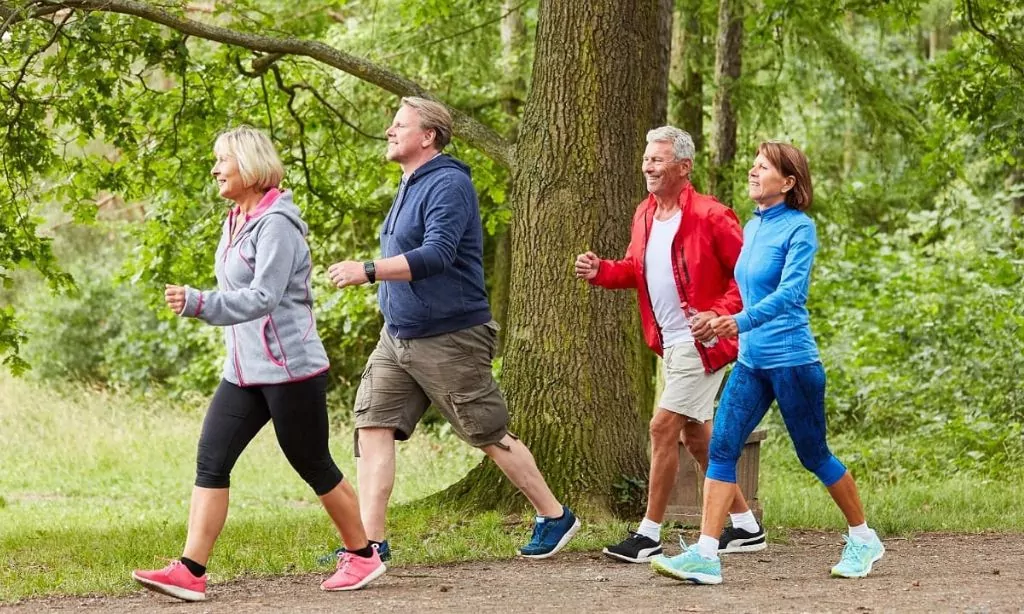Deciding to tackle an 11-mile walk is no small feat. Many wonder how long such a journey would take, considering the benefits and challenges that come with it. The average adult walks at a pace of 3 to 4 miles per hour, making this information crucial for planning.
In this guide, we’ll explore everything you need to know about walking 11 miles—from the time it typically takes to factors that might affect your speed and endurance. We’ll also dive into the health perks of walking and some essential safety tips to keep in mind.
Ready? Let’s get started!
Average Time to Walk 11 Miles

Walking 11 miles takes about 3 to 4 hours if you walk at a moderate pace. This pace is around 3 to 4 miles per hour. Everyone walks a bit differently, so times can vary.
Your speed might change based on how fit you are or the path you choose. Even the weather plays a role! But generally, plan for several hours of walking to cover this distance.
Factors Influencing Walking Speed
Several things can change how fast you walk. Your fitness level and the path you choose play big roles.
Fitness Level
Your fitness level plays a big role in how fast you can walk 11 miles. People who exercise regularly, like those who do strength training or interval training, often find they can walk faster and longer.
This is because their muscles are stronger and their cardiovascular health is better. If you’re new to walking long distances, you might start off slower. But don’t worry, with regular physical activity, your speed and stamina will improve.
Exercises such as hiking, running, and weightlifting boost your aerobic capacity. This means your body gets better at using oxygen efficiently during long walks. Plus, improved flexibility from stretching before walks helps prevent muscle soreness and injuries.
The key is consistency—making walking a part of your daily routine boosts your fitness level over time, making that 11-mile goal more achievable each day without feeling exhausted afterward.
Terrain
Terrain plays a crucial role in how fast you can cover 11 miles. Walking on a flat surface, your speed might hit between 3.5 to 4 mph. However, if the route goes uphill, expect your pace to drop to around 2.5 mph.
This change happens because climbing requires more energy and effort compared to walking on level ground.
Different terrains challenge your body in unique ways. For instance, walking through sand or snow demands more from your muscles than a smooth sidewalk does. Each step takes extra strength, slowing you down further but also providing a more intense workout.
Knowing this helps plan better for long-distance walks, ensuring you account for varied conditions along the path.
Weather
Weather conditions like wind, temperature, and precipitation can change how fast you walk. Strong winds or heavy rain might slow you down a lot. Cold days make it harder to keep warm, so you may not move as quickly.
When it’s hot outside, you might get tired faster and need more water because of dehydration.
Considering the weather is important for planning your walk. If it’s extremely cold or hot, think about adjusting your pace to stay comfortable and safe. Always keep an eye on the forecast before starting your 11-mile journey to avoid any surprises that could affect your walking speed.
Health Benefits of Walking

Walking boosts your health by fighting off diseases, trimming your waistline, and lifting your mood — dive into the details to discover even more benefits.
Cardiovascular Health
Regular walking strengthens the heart and reduces the risk of heart disease and stroke. It does this by lowering blood pressure, improving cholesterol levels, and enhancing blood circulation.
A strong heart pumps more efficiently, making everyday activities easier and less tiring. This simple exercise can be a powerful tool in managing weight too, which directly benefits cardiovascular health.
Taking a brisk walk every day increases your heart rate, promoting healthy blood flow and preventing high blood pressure. Over time, these benefits add up – keeping your heart in top shape while fending off chronic illnesses related to the cardiovascular system.
By incorporating regular walks into your routine, you’re not just moving your legs; you’re giving your entire circulatory system a boost.
Weight Management
Walking is a powerful tool for weight management. It burns calories, helps regulate blood sugar, and supports a healthy lifestyle. Pairing regular walks with a balanced diet can lead to losing weight.
The brisk pace of walking at 4 mph qualifies as moderate-intensity exercise, which is ideal for shedding pounds and avoiding chronic diseases.
Engaging in this physical activity also improves insulin sensitivity. This makes it easier to manage weight effectively. Walking not only reduces the risk of obesity but also guards against diabetes and heart-related issues.
Making it part of your routine boosts your chance to maintain or reach a healthier weight without feeling stressed about intense workouts.
Mood Enhancement
Walking regularly boosts your mood. It’s a natural way to fight stress and feel happier. Engaging in physical activities like walking increases the production of endorphins, chemicals in your brain that act as natural painkillers and mood elevators.
This process can help reduce feelings of depression and anxiety, making you feel more relaxed and positive.
Regular walks also improve overall well-being. They offer a chance to clear your mind, think more creatively, or simply enjoy the outdoors, providing a mental break from daily stresses.
Whether it’s a quick stroll around the block or an adventurous hike, moving your body has potent effects on enhancing mental health and combating conditions such as dementia and depression.
Joint Health
Regular walking strengthens the muscles around your joints, providing them with better support and reducing pain. This low-impact exercise is gentle on your joints and can greatly benefit those suffering from joint issues or arthritis.
It’s an effective way to boost flexibility and range of motion, making daily activities easier and less painful.
Exercising through walking also reduces stiffness and inflammation in the joints. Plus, it assists with weight management — a key factor in alleviating pressure on your joints. With each step, you’re not just moving towards better heart health; you’re ensuring your joints are healthier and more flexible too.
Immune System Boost
Walking plays a crucial role in keeping our immune system strong and healthy. This simple activity can help fight off diseases by improving the body’s ability to ward off infections and reducing the risk of chronic illnesses.
Think about it — moving your body gets the blood flowing, helps flush bacteria from your lungs and airways, and causes changes in antibodies and white blood cells. White blood cells are the body’s main defense against infections.
Every step taken contributes to a healthier immune system. Exercise like walking increases the release of endorphins, which not only boosts mood but also supports immune function. It’s like giving your body a shield against sickness without needing any special equipment or gym membership.
Plus, maintaining a routine that includes regular walks can keep you feeling great all year round, making you less likely to catch colds or other illnesses.
Safety Tips for Long-Distance Walking
Keep safe on your long walks by following essential tips, and dive deeper into our guide for more insights on making your journey enjoyable and injury-free.
Wear Comfortable Clothing and Footwear
Choosing the right clothes and shoes is key for a safe and comfy walk. Go for moisture-wicking fabrics that keep sweat away. This helps prevent chafing and keeps you cool. Shoes should fit well, supporting your feet without causing blisters or pain.
Always try on walking footwear before you buy them. Look for options with good cushioning and flexible soles. They should allow your feet to breathe, reducing the risk of heat exhaustion during long treks.
Dress in layers so you can adjust based on weather changes, ensuring comfort throughout your journey.
Stay Hydrated
Drinking enough water is a must for long-distance walkers. Your body loses fluids through sweat, even more so if you’re walking in warm weather. Aim to drink water before you feel thirsty.
This way, your body stays hydrated throughout your journey.
Carry a water bottle with you and take small sips often. Doing this keeps your energy levels up and helps prevent dehydration. Dehydration can lead to tiredness and less focus, making it harder to enjoy your walk or reach that 11-mile goal.
Plan Your Route
Choosing the right path for your long walk makes all the difference. Look into terrain and distance before stepping out. Maps, GPS, or smartphone apps are great tools to keep you on track.
Always have a backup plan in case of sudden changes or obstacles.
Safety comes first. Pick paths that are well-lit and have people around. Tell someone where you’re going and when you expect to be back. Pay attention to weather forecasts and time of day – they can affect your walk a lot.
Be Visible
Being visible is a key safety tip for long walks, especially in low-light conditions. Wearing reflective clothing and using lights or reflective gear helps ensure others can see you easily.
This simple step keeps walkers safe from traffic and other hazards.
Use lights on your clothes or carry a flashlight to make yourself more noticeable at night or early morning. Reflective bands are great for arms and legs because they move as you walk, drawing attention.
Drivers, cyclists, and even other pedestrians will appreciate being able to spot you from a distance.
Listen to Your Body
Listening to your body is a major safety tip for long-distance walking. It means paying attention to what your body tells you. If you feel pain, that’s a sign to stop and rest. Tiredness hints you might need to slow down or take a break.
Ignoring these signals can lead to injuries, turning an enjoyable walk into a struggle.
Staying hydrated and properly nourished plays a crucial role here too. Dehydration or lack of fuel can sneak up on you, often showing through headaches or dizziness. Catching these early signs helps prevent more serious issues like heatstroke or exhaustion.
Always keep water and snacks handy, ensuring your energy levels stay balanced throughout your journey.
Frequently Asked Questions (FAQs) about Walking 11 Miles
Walking 11 miles can seem like a challenge. Here are answers to some common questions to help you tackle it confidently.
- How long does it take to walk 11 miles?
- Does age affect how fast I can walk?
- What should I wear for long – distance walking?
- How can walking improve my health?
- Is there an ideal time of day for walking 11 miles?
- Should I eat differently if I’m planning to walk more?
- Can fitness trackers help me with my walks?
- What precautions should I take for safety?
Conclusion
Embarking on an 11-mile walk is a journey of both physical and mental endurance. The time it takes varies, largely depending on your pace, fitness level, and the path you choose. Remember—safety first; dress right, stay hydrated, and map out your route.
As you lace up for this adventure, embrace the incredible health benefits that come with every step. Let each mile be a testament to your determination and a step closer to achieving personal wellness goals.





























